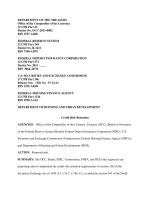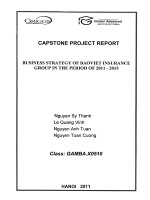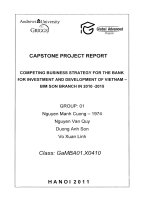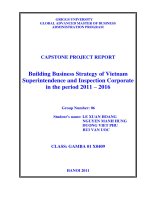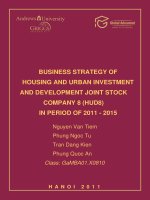BUSINESS STRATEGY OF THE HOUSING AND URBAN EVELOPMENT CORPORATION (HUD) IN VISION OF DEVELOPING THE MODEL OF VIETNAM REAL ESTATE GROUP
Bạn đang xem bản rút gọn của tài liệu. Xem và tải ngay bản đầy đủ của tài liệu tại đây (635.46 KB, 92 trang )
BUSINESS STRATEGY OF THE
HOUSING AND URBAN EVELOPMENT
CORPORATION (HUD) IN VISION OF
DEVELOPING THE MODEL OF
VIETNAM REAL ESTATE GROUP
CONTENT
PAGE
INTRODUCTION.....................................................................................................4
CHAPTER 1: KEY THEORETICAL BASIS FOR BUSINESS STRATEGY
FORMULATION OF THE HOUSING AND URBAN DEVELOPMENT
CORPORATION.......................................................................................................7
1.1 Concepts of business strategy.........................................................................7
1.1.1 Definition of a business strategy................................................................7
1.1.2 Strategic management process...................................................................7
1.1.3 Necessity and the role of a business strategy...........................................11
1.2 Substances in enterprises’ business strategy formation.............................14
1.2.1 Defining duties and objectives of the enterprise......................................14
1.2.2 SWOT Analysis........................................................................................15
1.3 Business strategy implementation ..............................................................29
1.3.1 Objectives, conditions of the business environment and the selected
strategies...................................................................................................29
1.3.2 Organize the implementation apparatus...................................................29
1.3.3 Allocation and adjustment of resources...................................................30
Page 1
1.3.4 Set up a plan of implementation...............................................................31
1.3.5 Designing strategy’s structure and control system..................................31
1.4 Monitoring and Evaluation (M & E)...........................................................34
CHAPTER 2: EVALUATING THE REALITY OF BUSINESS STRATEGY
FORMULATION TASK AT THE HOUSING AND URBAN DEVELOPMENT
CORPORATION (HUD) .......................................................................................36
2.1 General features of the Corporation............................................................36
2.1.1 Establishment and development process of the Corporation..................36
2.1.2 Features of Corporation’s business operation..........................................37
2.2 Current situation of business strategy formulation of HUD......................45
2.2.1 Objectives and philosophy in business strategy of HUD........................45
2.2.2 The process of corporate strategy formulation........................................47
2.2.3 The Corporation’s corporate strategy formulation method.....................50
2.2.4 Implementation organization....................................................................50
2.2.5 The Corporation’s business strategies......................................................53
2.3 Remarks on HUD’s business strategy formulating.....................................75
CHAPTER 3: SOLUTIONS TO IMPROVE HUD’s STRATEGY
FORMULATION TASK.........................................................................................77
3.1 Strong points, weak points, Opportunities, Challenges in the HUD
Corporation’s business strategy formulation task....................................77
3.1.1 Opportunities............................................................................................77
3.1.2 Challenges.................................................................................................78
3.1.3 Strong points.............................................................................................79
3.1.4 Weak points..............................................................................................80
3.2 Several solutions by HUD’s Leadership Board to improve its business
strategy formulation task ............................................................................80
3.3 Some suggestions and recommendations to improve HUD’s business
strategy formulation task ............................................................................82
Page 2
CONCLUSION........................................................................................................91
REFERENCE..........................................................................................................93
INTRODUCTION
1. Necessity and meaning of HUD’s business strategy formulation
Our economy is operating on a state-regulated market regime and has been
increasingly integrating into that of the region and the world. To ensure successful
economic integration, the first responsibility is laid on the shoulder of enterprises.
Stemming from that reality, each enterprise is required to build their business
strategies that are closely linked to international integration. A precise business
strategy plays a decisive role in the success of an enterprise, guiding the enterprise
toward a sustainable development in the market economy regime. A business
strategy also helps members of the enterprises be well-aware of the aims and
direction of their enterprise so that they can clearly figure out what and how they
should do. Besides, business strategies facilitate the enterprises to timely grasp and
utilize the opportunities as well as minimize the risks due to upheavals in the
business environment.
The Housing and Urban Development Corporation is among the leading brand names
in the area of housing and urban development. With its 20 year experience of
operation and development, its status is increasingly consolidated and enhanced in
domestic and foreign markets. Currently, the company is operating under the model
of parent-subsidiary companies with the parent company as the state-owned
Page 3
enterprise operating in line with the Law on Enterprises and 16 subsidiary companies
including 15 joint-stock companies, 1 state-own limited one member company and
11 affiliates. To ensure the company’s sound development in the future, the urging
issue to be addressed is that it should be able to build a stable and long-term business
strategy that is flexible upon the ups-and-downs in the business environment;
develop the company into a cooperation to meet increasing needs for housing and
urbanization, thus contributing to the nation’s cause of industrialization and
modernization.
Over the past years, HUD has set up an appropriate business strategy, thus enabling it
to have solid developments. However, improving business strategy formulation to
develop the Company into a strong Cooperation in the area of housing and urban
development is a matter of strategic importance, especially against the backdrop of
our economy’s deeper integration into the world’s. Therefore, our group has chosen
the issue of “Business strategy of the Housing and Urban Development Corporation
with linkage to the construction model of a Vietnam’s Real Estate Group” to be the
grand exercise for the graduation of the Master of Business Management Program.
2. Exercise’s objectives and responsibilities
a. Objectives
Studying the matters of theoretical and practical manner as well as evaluate the
reality of the Company’s business strategy formulation in order to suggest solutions
for improving the business strategy formulation task to serve as a basis for turning
the Company into a real-estate business group.
b. Responsibilities
- Studying theoretical matters on business strategy formulation within the
enterprises.
- Analyzing the business strategy formulation current situation at the Housing
and Urban Development Corporation.
Page 4
-
Proposing solutions to improve the business strategy formulation task at the
Housing and Urban Development Corporation as the basis for the
establishment of a national group operating in the field of housing and urban
development.
3. Exercise’s subject and scope of study
- The exercise’s object of study is the business strategy formulation task in
enterprises.
- The exercise’s scope of study is to focus on studying the business strategy
formulation task at HUD during the period of 2009-2010 and its development
orientation to 2015.
4. Practical issues of the exercise that may contribute to the Company’s business
strategy
- Systematizing some theoretical issues relating to the business strategy
formulation of enterprises that can be used as reference materials for business
strategy formulation task for enterprises.
- Contributing to helping HUD map out fundamental orientation in the process of
analyzing and evaluating the business strategy formulation current situation at the
Company, through which shortcoming and their origins can be found out.
- Helping improve the business strategy formulation task at HUD, thus
contributing to the formation of a development strategy to set up Vietnam’s Housing
and Urban Development Group.
5. Exercise’s structure
The exercise is divided into 3 chapters:
Page 5
Chapter 1: Key theoretical basis on the Corporation’s business strategy formulation.
Chapter 2: Evaluation of the Corporation’s business strategy formulation task.
Chapter 3: Solutions to improve the Corporation’s business strategy formulation task.
Page 6
CHAPTER 1
KEY THEORETICAL BASIS FOR BUSINESS STRATEGY FORMULATION OF
THE HOUSING AND URBAN DEVELOPMENT CORPORATION
1.1 Concepts of business strategy
1.1.1 Definition of a business strategy
So far, there have been many definitions of a business strategy, among which these
two following ones are most popular:
- A business strategy is a plan of projecting and controlling business activities of
the enterprise including identifying the objectives of the business strategy (3 years, 5
years, 10 years etc); decision-formulation process of the enterprises and analysis of
the business environment. In other words, the business strategy is a “product” that
can be combined with what the environment has; what the Company may have; and
what it wants to have. Therefore, the nature of a business strategy is the means
toward long-term objectives and the ideas of a business strategy is the aim of
winning in competition and business market.
- A business strategy is a set of long-term objectives, policies and grand solutions
on business and manufacture; finance; as well as human factors in order to bring the
enterprise’s business into a new height with higher quality.
1.1.2 Strategic management process
The concept of management have long come into being, however, it is not until the
end of XIX and early XX centuries that theories of management including ideas and
thoughts systematized and studied based on scientific analysis did appear with the
school of scientific management and the newly released school of quantitative
management to fit with the need for competitiveness in modern business activities.
Page 7
Strategic management is a process of studying the environment to form strategic
objectives, policies and solutions for enterprises’ business; to put these business
policies and strategies into practice so as to make decision on adjusting, monitoring
and evaluating the implementation process of these business policies and strategies.
1.1.2.1 Strategy formation period
Strategic formation is a process of setting up business duties, implementing study
and research to identify inner and external factors, outlining long-term objectives and
selecting alternative strategies. This strategy formation period is sometimes called
“strategy plan-formulation”. Strategy formation involves 3 fundamental activities:
- Conducting studies relating to the collection and digestion of data and
information on the market and business sectors of the enterprise. This process is
called “having a glance at the business environment”. In essence, conducting this
study is to define important strengths as well as weaknesses in the functional
business area. Different forms of surveys may be developed and conducted to study
inner factors i.e. staff’s spirit, production efficiency, advertising effectiveness and
customers’ loyalty.
- Combining intuition and analysis: several administrators and enterprises’ owners
think that certain particular gifts may count in using intuition for initiating excellent
strategies. Although some organizations nowadays can survive and prosper thanks to
intuitive geniuses in management, the majority might not be as so lucky. Most
organizations can, instead, make benefits by combining in tandem between intuition
and analysis in decision formulation.
- Decision formulation: since no organization can have unlimited resources,
strategists ought to make decision as to what alternative strategy should be selected
to bring most benefits to the company. Decisions during the strategy formation
period should link the organization with the products, markets, resources and specific
technologies within a prolonged period.
Page 8
1.1.2.2 Strategy implementation period
- Strategy formation is usually deemed the period of actions of strategic
administrators. Implementation implies the mobilization administrators and staffs to
carry out the set strategies. Fundamental activities in this period include:
- Setting up annual targets: i.e. landmarks that organizations have to fulfill toward
longer-term objectives. Annual targets should be measurable, quantitative,
challenging and prioritized. These targets are normally set at the company, section
and functional office levels in a big company. They should be released under the
form of achievements in management, marketing, finance, accounting, operation, and
information R&D. A series of annual targets is needed for each long-term objective.
These annual targets are extremely important in the strategy in the sense that they are
the basis for resource distribution.
- Policies: policies are means toward ends. They include instructions, regulations
and procedures given out to support efforts toward the set targets. Policies are the
guidance for decision-formulation and reflect repetitive or periodic situations.
Policies as well as annual targets are of great importance in strategy implementation
as they cover expectation of the staff and administrators in the organization. Policies
also enable cooperation and inner synchronizing among different departments within
the organization.
- Resource distribution: this is a central administrative activity taking into account
the strategy implementation. Strategic management allows resources to be distributed
according to priorities set by annual targets. Nothing should be more harmful to the
strategic administrative process and the organization’s successes than the fact that
resources are distributed in an inappropriate ways against the priorities that have
been adopted in annual targets. All organizations have at least 4 categories of
resources that can be used for achieving the targets:
+ Financial resources;
Page 9
+ Material resources;
+ Human resources;
+ Technological resources.
In short, the strategy implementation period is the most difficult one. It requires
discipline, devotion and sacrifice from each individual. A successful implementation
of strategy depends on the administrator’s capability to mobilize staff, usually
deemed as an art rather than a science. A strategy which has been set but cannot be
implemented will not serve any useful objective.
1.1.2.3 Strategy evaluation period
Most strategic makers agree that strategy evaluation period is essential to bring
prosperity for the organization. Timely evaluation can raise an alarm for
administrators about obstacles or warn possible obstacles before a situation becomes
serious.
Timely and fully responsive information as the foundation for strategic evaluation
may be nothing different from current available information. So much pressure from
leading administrators may render lower-level ones to figure out data that they think
will satisfy the higher-level.
Although one or many strategies may be right, however, this kind of theoretical
thinking may be wrong in that strategic evaluation embraces both short-term and
long-term objectives. Normally, these strategies do not affect short-term activity
outcomes until it has been so late to make necessary changes. It can not be verified
that a typical strategy is the best or guaranteed that it can act. Nevertheless, it can be
evaluated through serious mistakes. Richard Rumel has suggested 4 criteria for
strategic evaluation, namely consistency, suitability, favorableness and feasibility.
Strategic management process.
Including: Commitment → Decision → Action
Page 10
Strategic competitive advantages:
- Sustainable competitive advantages;
- Above-averaged revenues.
1.1.3 Necessity and the role of a business strategy
1.1.3.1 Necessity
- Financial benefit
Studies show that companies with good and clearly-designed strategies will earn
higher revenues and success in doing business. Practical evidence from successful
companies suggests a strategic orientation with more long-term emphasis.
Companies with big financial achievements tend to make a systematic plan to
prepare for future upheavals in the inner and external operation environment, thus
bringing about great outcomes of financial records in their fields of business.
Annually there are about 20,000 enterprises in the United States plunged into
bankruptcy and 50,000 cases of failure in business. There are many causes
contributing to those failures apart from the lack of a clear and efficient strategy, yet
statistics also show that strategies can create financial advantages in the company.
- Non-financial benefits
A strategy, apart from showing that the company can earn profits as expected, also
reveals apparent benefits. Once a strategy is in hand, the enterprises’ operation will
go on a clear track which in turn, can easily render success in business and high
profits i.e. first of all enable the enterprises to survive and develop, following by
stability in politics, organization and other relationships etc, specifically to increase
productivity, enhance prevention capability of obstacles posed for the company.
Besides, the strategy’s success also brings about order and discipline in the company.
It may be the beginning of an effective and efficient administrative system, restore
confidence in the current business strategy or suggest necessary adjustments.
Page 11
1.1.3.2 Roles
Against the background of many upheavals in the current market, more than ever,
the only thing that enterprises may know for sure is changes. Strategic management
is like a path that helps these organizations overcome ups and downs in the market,
striving toward the future by their own efforts and capabilities. The business strategy
is built to aim at helping enterprises concentrate on how to best adapt toward changes
in the long-term.
- Strategic management helps an organization be more proactive instead of being
passive in outlining its future. It also enables an organization to be a pioneer and
exert its influence in its operating environment and thus bringing into full play its
capacity to control and overcome sea of changes.
- Strategic management creates in every person an important awareness. Both the
Director Board and employees thoroughly understand and commit to implement
enterprise’s objectives. Once every staff in the enterprise understands what it is doing
and why it is doing so, they will feel that they are a part of the enterprise and will
commit to support every of its activities.
From the above-mentioned concepts of a business strategy, fundamental features
of a business strategy can be clearly seen, those are:
- The business strategy has to clearly identify fundamental goals needed to be
obtained for each period and thoroughly grasped in all aspects and levels of the
business and production activities of the enterprise.
- The business strategy has to ensure to mobilize and combine to the utmost the
exploitation and use of resources (human resources together with other visible and
invisible property). It is also compulsory to bring into full play, both in the presence
and future, the advantages and grasp any opportunity to gain advantages in
competition.
Page 12
- The business strategy of the enterprise is manifested throughout a continuous
period from strategy formation to implementation, evaluation, monitoring to
adjustment.
- The business strategy is designed to be implemented for a rather long time
(usually 3 years, 5 years, 10 years etc).
With those characteristics, it can be said that the formation and implementation of a
business strategy, particularly in the market regime, is of significant meaning for the
survival and development of the enterprise in that:
- It helps the enterprise well recognize their goals and path forward to serve as the
foundation for identifying which orientation the enterprise should take for their
production and business and when it can reach certain objectives.
- Upheavals in the market always create both opportunities and challenges.
Building a strategic implementation will thus help the enterprise to grasp and utilize
the opportunities to overcome risks and traps of the market.
- Building the strategic implementation will set up solid bases for the enterprise to
make decisions in line with developments of the market.
- Building the strategic implementation also plays a decisive role in increasing the
efficiency in resource using and in enhancing competition status to ensure a
sustainable development for the enterprise.
1.2 Substances in enterprises’ business strategy formation
1.2.1 Defining duties and objectives of the enterprise
Objectives are the desired outcomes that the enterprise should strive for. The
objectives guide all decisions and form measurable criteria for implementation in
practice.
Page 13
An enterprise is established with certain aims. Nevertheless, it does not always
clearly understand its duties, resulting in the fact that the tasks completed do not
bring about high efficiency as expected. Sometimes, due to not mastering the set
objectives and duties, these enterprises have chosen the wrong way, formulation all
follow-up efforts become meaningless. The enterprises, therefore, should know from
the very beginning the tasks that they need to implement.
Defining the strategic objectives and duties of the enterprise is a very important start
in the implementing the strategic business management. Clearly defining and
specifying the objectives is an important step for the enterprise’s success.
* Principles in defining objectives:
- Concreteness: the objectives should clarify the following questions: what are the
relevant issues? how is the implementation progress? what are the final outcomes
that need to be obtained? The more specific the objective is, the easier it becomes to
project a strategy to implement that objective. Concreteness hereby implies
quantifying the objectives i.e. they should be defined under the form of concrete
targets.
- Feasibility: a set objective must be feasible; otherwise it may become
adventurous or counter-productive. Consequently, if the objective is too ambitious,
the implementers will be discouraged whereas a modest one will be ineffective.
- Consistency: the set objectives should be harmonious with each other so that the
implementation process of one objective will not hinder that of the other.
Contradicting objectives usually lead to intra-enterprise contradictions; hence, it
should be wise to prioritize the objectives. The objectives, however, are not always
completely consistent with each other. In such a case, there should be reconciling
measures in the implementation of objectives.
- Flexibility: the set objectives have to be adjustable to adapt to changes in the
environment so as to avoid risks and grasp opportunities. Yet, it should be cautious in
Page 14
changing objectives as these changes require to go hand in hand with respective
changes in relevant strategies as well as the plans of action.
1.2.2 SWOT Analysis
All enterprises have their own strong and weak points in their area of business. No
enterprise has only weaknesses or strengths in all aspects. Inner weak and strong
points as well as external risks and opportunities are fundamental features that the
enterprises should take into account on forming their strategies. Identifying weak and
strong points has to be made in comparison with other enterprises operating in the
same field and the operation results of the enterprise. Enterprise’s strong points are
those whereby it does better than its competitors and that other enterprises do not
easily possess. Together, these strong points create the competitive advantages of the
enterprise. The weak points are enterprise’s shortcomings which should be adjusted
when the enterprises form its strategy.
1.2.2.1 Analyzing the external business environment to identify opportunities
and challenges
The enterprise’s external business environment is a set of objective factors that may
have direct and indirect impacts on its business activities.
The aim of evaluating the external environment is to make a short list of
opportunities from the environment that the enterprise should grasp as well as the
risks posed by the environment, possibly leading to challenges for the enterprise that
it should avoid. Within the scope of impacts of the business environment, they
include:
- International environnement;
- National economic environnement;
- Business sector environment.
1. Analyzing the impacts of the international environment
Page 15
Analyzing the international environment gives us a partial answer for the question:
what is the enterprise facing with? There are 5 factors from the international
environment that the enterprise should cope with, namely world politics,
international economics, international laws, world science and technology, and
international culture. These factors have independent impacts or combining ones
with other factors on the organization.
- World politics: At the one hand, political stability and peaceful coexistence are
maintained; at the other hand, military, political and diplomatic influence is
prolonged. This factor creates both opportunities and challenges for enterprises’
import-export activities.
- International economy: international economic organizations, multi-national
corporations, international economic growth rate etc affect world supply and
demand, prices, international competition, wide and in-depth level of integration into
world market etc;
- International laws: rules and laws of international organizations i.e. WTO, WB,
IMF, ISO, together with bilateral and multilateral agreements are intertwined. If
mastered, it will be an opportunity, otherwise, a risk;
- World science and technology: An opportunity if following the trend to shorten
the development gap; a risk if slowly renovated;
- International culture: influence from foreign cultures of developed nations;
contradictions and conflicts among different cultures. It is required to absorb with
selection, be self-adapted, and build the enterprise’s culture with its own
characteristics to develop. A risk may be inevitable if completely dissolved and
dependent.
2. Impacts from the national economic environment
- Politics and laws are the legal framework of the business environment and the
economic role of the state i.e. political and policy stability of the state, improvement
Page 16
and legal effect in practice. It is an opportunity if the business environment is stable,
equitable, and competitive and the role of enterprises and businessmen are honored; a
risk if otherwise.
- Economics: economic growth rate, bank’s interest rate, inflation, increase in
investment etc all have impact on supply and demand, and the prices of commodity
and service. This is an opportunity if they create favorable conditions for enterprises,
a risk when the economy slows down, inflation and investment fall.
- Technology: levels of technology material and infrastructure, policy of science
and technology development, investment, technological transfer, intellectual
property. This is an opportunity if investment on technological innovation and
registration of trademarks are made, otherwise a risk.
- Natural conditions and infrastructure: include transport, communication, level
of environmental pollution, the state’s role in environmental protection. It will be an
opportunity if enterprise’s business operation is facilitated, otherwise the enterprise
may have to increase business expenditure.
- Social culture: the trend of upheavals in the young population, tendency of
family mobilization, life style, psychological habits, religion etc. This will be an
opportunity should analysis be done to actively welcome changes; a risk should the
above-mentioned impacts are not well-understood.
3. Analyzing the business sector’s environment
a. Customers
- Based on number of people in the family, psychology, purchasing attitude and
scope of geography.
+ Purchasing volume;
+ Relationship with the enterprises;
+ Purchasing goals;
Page 17
+ Geographical location;
+ Economic components: private sector, collective, state-owned enterprises,
government organs and non-profitable organizations.
- This is an opportunity if the customers are “weaker” than the enterprises,
otherwise a challenge should they are “stronger”.
b. Competitors
- Competitors are providers of similar or alternative products to the enterprises’
in the market.
- Types of competitors in the market
+ Based on the status of the enterprises, including leading companies, following
ones, and those who are looking for a place in the market.
+ Based on the products: competitors in products, competitors in types of
products, competitors operating in the business field and competitors in dividing
profits from a group of customers.
- It is necessary to collect information about the competitors i.e. classifying them,
their goals and judgment about them as well as their strategies and potentials.
- Define the level of market competitiveness basing on the following factors:
+ Number of competitors;
+ Level of growth in the business sector;
+ High or low fixed costs;
+ Market demand;
+ Barriers in withdrawing from the business sector.
Page 18
On that foundation, the enterprise’s mode of doing business and competitive means
in the market should be defined.
c. Suppliers
- Are providers of commodity and service for the enterprise and its competitor.
- Suppliers are “stronger” than the enterprises may be a disadvantage in the cases
i.e. there are limited suppliers, the enterprises do not have capability to search for
other suppliers; or the products are not important to suppliers but to the enterprises.
- Otherwise, if suppliers are “weaker” than the enterprise, it will be an advantage.
- It is necessary to select and diversify suppliers and sources of products to
reduce input costs.
d. Trade intermediaries
Including individuals, collectives, and organization participating in propaganda,
advertising, transport, distribution, sale and service for the enterprises.
- Types of trade intermediaries include retail agents, sale brokers.
- Benefits on using sale agents.
- To be a broker, a profound understanding of the products, master of
communication, customer persuasive skills, and a reasonable distribution of broker
cost are very much required.
- The enterprise should have measures to study, classify, select and link the
intermediaries so that they can sell goods for it.
e. Public relations
They are any groups of people that have the rights and impacts on business
capability of the enterprise including the government, social opinion, active public
and inner public.
Page 19
- The public plays a role of multiplying enterprise’s reputation, supporting its
business and increasing its social responsibilities.
- Measures to enhance public relations:
+ Investing time and effort;
+ Well fulfilling the enterprise’s social responsibilities;
+ Protecting the natural and ecological environment;
+ Selecting an experienced and prestigious spokesman.
1.2.2.2 Analyzing internal factors that can increase competitiveness and enable
the enterprise to gain advantages against its competitors
All organizations have strengths and weaknesses within their functional units. There
is no organization with only all strengths or weaknesses in every area.
Strengths/weaknesses, opportunities/challenges clearly lay the foundation for
forming objectives and strategies. Evaluating the inner environment is to check and
review all aspects of the company and intra-unit relations as well as point out its
strengths and lingering weaknesses, serving as the premise for maximizing strengths
and minimizing shortcomings and correcting existing weaknesses. Weaknesses
hereby imply attributes that reduce the enterprise’s resources as compared to its
competitors.
1. Products and business area
Regulations on the enterprise’s targets and scope of operation include products,
volume, commodity structure, current product life circle, trademarks, supply service
and quality.
Decisions on the scope of business, apparatus, and modes of business will affect the
2. 2. Human resources and human resource management
Page 20
Quantity, structure, quality of the human resources; training and education of human
resources; use, treatment, encouragement of labors; and enterprise’s regime of human
resource management.
3. Information system
The information system should be complete, updated, reliable and efficient enough to
enable leaders to make precise decisions.
4. Enterprise’s management activities
Key officials, organizing structure, operation mechanism (proper decentralization)
will lead to suitable decisions in accordance to market situations and create value
added for the enterprise.
5. Marketing activities in business
It is necessary to build a marketing strategy for the focal market. Parameters i.e.
products, prices, distribution, promotion comprehensively and harmoniously used
will help reduce costs and increase marketing efficiency.
6. Financial factors and business effect
The quantity, business capital structure, sources of funding, fund allocation to
business activities, increased liquidity, checked incomings and outgoings, and
financial management regime will help increase business effect.
7. Enterprise’s cultural order and discipline
Enterprise’s regulations, etiquette and formalities in meetings, business philosophy,
anecdotes about leaders with entrepreneurial, sectional and national characteristics
will be an apparent advantage. Unclear characteristics will be a weak point.
8. Enterprise’s brand name and reputation
Page 21
Product’s trademarks, brands, symbols, slogans, packing, geographical instructions,
features of intellectual property are necessary components of a strong brand name.
9. Science and technology
Inventions, innovations, new scientific and technological applications, and favorable
geographical locations if reasonably invested will create strengths for the enterprise.
1.2.2.3 Methods of evaluating the business environment
When analyzing and evaluating factors of the business environment, there will be
thousands of emerging opportunities and challenges that needs measures taking into
account the most attractive opportunities and the worst threats.
Most frequently used methods:
• General table about the business environment.
• Matrix of internal and external factors.
• Analyzing SWOT matrix.
• Priority order of opportunities and challenges.
To synthesize the above analyzing process, it is quite sensible to make use of the
SWOT matrix.
* Matrix SWOT (Strengths, Weaknesses, Opportunities, Threats)
S (strengths)
O (Opportunities)
T (Threats)
W (Weaknesses)
Page 22
To form the matrix SWOT, it’s necessary to first name the strengths, weaknesses,
opportunities and threats through a matrix based on classifying the order of priorities.
Next, a systematic comparison at each respective level among the factors should be
carried out to identify the coordinating level.
- S/O coordination can be made by combining key strengths with opportunities of
the enterprise. The enterprise should make use of its strengths and opportunities to
compete with others so as to unceasingly enlarge its market.
- W/O coordination is the combination between enterprise’s weaknesses and its
opportunities. This combination opens a chance for the enterprise to surmount
weaknesses and take advantage of opportunities.
- S/T coordination is the combination between strengths and threats in which due
attention should be given to using strengths to overcome threats.
- W/T coordination is the combination between enterprise’s weaknesses and
threats. This combination poses a requirement for the enterprise to adopt measures to
reduce weaknesses and avoid threats by imposing prevention strategies.
1.2.2.4 Forming and selecting types of business strategies
1. Functional strategy
Create competitive advantages by means of functional strategies.
a. Achieving significant efficiency.
- Economy of scale.
- Learning effect.
- Experience curve.
- Flexible production upon customer’s demands with big volume.
- Marketing and its efficiency.
Page 23
- R&D strategy and its efficiency.
- Human resource strategy and its efficiency.
- Information system, Internet and its efficiency.
b. Achieving excellent quality.
In order to gain excellent quality, the entire enterprise is required to commit to
quality and have a clear customer-based focus.
c. Achieving exceeding improvements.
Failure ratio in new product introduction is quite high due to factors i.e. uncertainty
in poor commercialization, poor location strategy, technological short-sightedness
and slowness in introducing the product into the market.
d. Establishing improvement capability.
Companies can carry out some steps to set up an improvement capability and escape
from failure. Those three seemingly most significant steps are:
•
Form basic and applied research skills;
•
Develop a good project’s selection and development process;
•
Combine, to a certain extent, different functions within the company through
the inter-functional product development group and paralleled development
processes.
e. Achieving exceeding rate in meeting customer’s demands.
- Focus on customers;
- Satisfy customer’s demands;
- Achieving exceeding rate in meeting customer’s demands.
2. Strategy at the business level
Page 24
a. Strategy at business section level.
Strategy at the business section level is the combination of commitments and actions
that help the enterprise gain competitive advantage by bringing into full play its core
capabilities in specific productivity market.
b. Selecting a common business strategy.
A successful strategy for competition must base on sources of competitive
advantages. The enterprises will have to strive consistently to form competitive
advantages through an unlimited series of strategies. A strategy for competition is
designed to make use of the value chain and other strengths to form the competitive
advantages. Although there are various competitive strategies, generally there are
only 3 fundamental approaches to form the competitive advantage, namely leading
cost strategies, formulation difference strategies and concentrated strategies.
c. Groups of strategies and business strategies.
Companies operating in the same field can pursue different types of business
strategies whose differences relate to factors i.e. selection of market segment for
serving, quality, productivity, leading technology, customer serving, assessment and
advertising policies.
d. Selection of an investment strategy at the business section level.
It’s obligatory to invest on an investment strategy which forms the value and type of
functional and financial human-personnel resources to gain competitive advantage.
•
Competitive status;
•
Life circle effect;
•
Selection of investment strategy.
3. Strategies at the company level
a. Focus on a single business area.
Page 25
